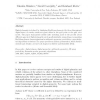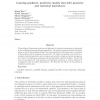101 search results - page 3 / 21 » The Lie Model for Euclidean Geometry |
PAMI
1998
13 years 7 months ago
1998
—Deformable template representations of observed imagery, model the variability of target pose via the actions of the matrix Lie groups on rigid templates. In this paper, we stud...
GIS
1992
ACM
13 years 11 months ago
1992
ACM
Theoretical and empirical work on the geometry of environmental knowledge is discussed. Certain patterns of distanc.e and directional estimates collected from humans have been inte...
DAM
2007
13 years 7 months ago
2007
Digital planarity is defined by digitizing Euclidean planes in the three-dimensional digital space of voxels; voxels are given either in the grid point or the grid cube model. Th...
CVPR
2008
IEEE
14 years 9 months ago
2008
IEEE
Recently, a novel Log-Euclidean Riemannian metric [28] is proposed for statistics on symmetric positive definite (SPD) matrices. Under this metric, distances and Riemannian means ...
JMLR
2010
13 years 2 months ago
2010
The problems of dimension reduction and inference of statistical dependence are addressed by the modeling framework of learning gradients. The models we propose hold for Euclidean...


